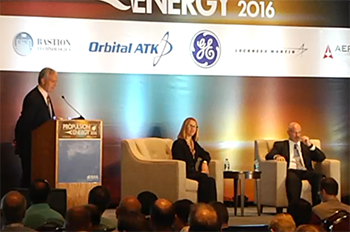Stretch Goals Eyed in Additive Manufacturing of Rocket Engines Written 27 July 2016
Speakers: Moderator Randy Furnas, chief of the power division, Research and Engineering Directorate, NASA’s Glenn Research Center; Elizabeth Robertson, team lead, Liquid Engine Systems Branch, NASA’s Marshall Space Flight Center; Jay Littles, director of advanced launch vehicle propulsion, Aerojet Rocketdyne
By Ben Iannotta, Aerospace America Editor-in-Chief

Makers of rocket engines have plenty of evidence that costs and production time can be significantly reduced by making some components almost entirely through additive manufacturing, in which metal powder is laid down and fused by laser or electrons.
Engine makers have now defined the next steps, which will include defining standards and inspection processes to win customer confidence in additively manufactured components.
Elizabeth Robertson, leader of the Liquid Engine Systems Branch of NASA’s Marshall Space Flight Center in Alabama, said additive manufacturing has great promise, but she cautioned that there may be limits on “human rating” of components until inspection issues are figured out.
Jay Littles, director of advanced launch vehicle propulsion at Aerojet Rocketdyne, said one of additive manufacturing’s great advantages — a reduction in the parts count — also creates a disadvantage. Conventionally manufactured parts can be inspected individually, but an additive component subsumes many parts into just a few pieces that are joined together.
These “complex geometries” complicate inspection, Littles said. “You can’t go in and look at these.” A big challenge is “basically how you do the quality assurance.”
Robertson and Littles led the July 27 session “The Impact of Additive Manufacturing on the Design Process” at the 2016 AIAA Propulsion and Energy Forum in Salt Lake City.
Littles said other goals include making larger components and understanding the performance of specific additive manufacturing machines.
“We’re in the Betamax-tape part of this additive thing,” he said, referring to the 1970s-era Sony videotape standard that was beat out by VHS. “It’s going to be interesting to see where we go over the next decade.”
As powerful as additive manufacturing is proving to be, Aerojet Rocketdyne also has learned some of its limits.
“Additive really does open up the design window, but there’s also a lot of stuff that you can’t do — geometries to avoid,” Littles said.
While inspection might be a challenge, Robertson said a smaller part count is also “fantastic when you think about reliability.”
She recounted that in 2012, NASA decided to make components for a prototype engine to demonstrate additive manufacturing. Managers saw a 30 percent reduction in cost and part reduction from 250 to six, she said.
NASA also sees some limits to additive processes.
“If you have a part rotating at 90,000 rpm, you’re probably going to have to do machining to clean that up,” Robertson said.
Overall, “There are a lot of challenges that remain,” Robertson said. “We sometimes found that quality would follow people, rather than a company. Right now, additive is still an art.”
